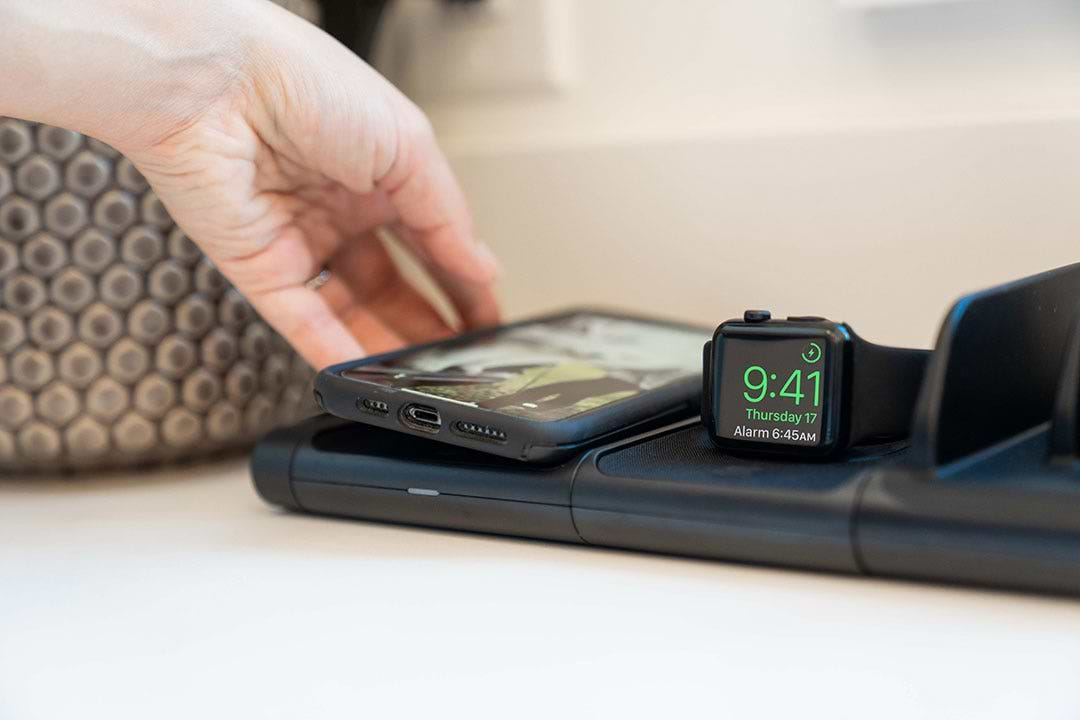Impact on Battery Health: Wireless Charging Insights

In our increasingly mobile world, the demand for wireless charging has skyrocketed. As more and more devices adopt this convenient technology, questions arise regarding its impact on battery health. In this article, we will delve into the intricacies of battery lifespan, how wireless charging works, and uncover the truth behind common myths. Additionally, we will explore best practices for optimizing battery health with wireless charging and discuss future developments in this field.
Understanding Battery Health
The Basics of Battery Lifespan
Battery lifespan refers to the duration of time that a battery can retain its original capacity. It is typically measured in charge cycles, where one full charge cycle is the process of completely charging a battery and then completely discharging it. The number of charge cycles a battery can endure before its capacity significantly declines varies depending on several factors.
Let's dive deeper into the factors that can affect battery health and learn how to maximize the lifespan of your device's battery.
Factors Affecting Battery Health
Several factors can affect battery health, including:
- Temperature: Extreme temperatures, both hot and cold, can negatively impact battery performance and longevity. It is essential to avoid exposing your device to excessive heat or cold.
- Charge Level: Keeping your battery consistently charged between 20% and 80% can help prolong its lifespan. Frequent deep discharges or overcharging can degrade the battery faster.
- Charging Speed: Fast charging technologies can generate more heat and may reduce battery lifespan over time. It is advisable to use the manufacturer-recommended charging accessories.
Temperature plays a crucial role in battery health. High temperatures can accelerate the chemical reactions within the battery, causing it to degrade faster. On the other hand, extremely cold temperatures can slow down the chemical reactions, reducing the battery's overall performance. To ensure optimal battery health, it is recommended to keep your device within the temperature range specified by the manufacturer.
Charge level management is another important aspect of battery health. While it may be tempting to let your battery drain completely before charging it or to keep it plugged in all the time, both practices can have negative effects on the battery's lifespan. Frequent deep discharges can put additional stress on the battery, while overcharging can lead to increased heat generation, potentially damaging the battery cells.
When it comes to charging speed, it's important to strike a balance between convenience and battery health. Fast charging technologies have become increasingly popular, allowing users to quickly recharge their devices. However, these technologies can generate more heat during the charging process, which can impact the battery's longevity. To ensure the best possible battery lifespan, it is advisable to use the charging accessories recommended by the device manufacturer, as they are specifically designed to provide the optimal charging speed for your device.
By understanding these factors and implementing good battery management practices, you can maximize the lifespan of your device's battery. Remember to keep an eye on the temperature, maintain a healthy charge level, and use the appropriate charging accessories. Taking these steps will help ensure that your battery remains in good health, allowing you to enjoy your device for longer periods without worrying about battery degradation.
The Science Behind Wireless Charging
Wireless charging is a revolutionary technology that has transformed the way we power our devices. It utilizes electromagnetic fields to transfer power from a charging pad or mat to a compatible device, eliminating the need for traditional wired chargers.
How Wireless Charging Works
At the heart of wireless charging is the principle of electromagnetic induction. Inductive charging, the most common wireless charging method, involves the use of two copper coils - one in the charging pad and another in the device.
When an electric current passes through the charging pad's coil, it generates an electromagnetic field. This field, in turn, induces a current in the device's coil, which charges the battery. It's like magic happening right before your eyes!
But how does this electromagnetic field transfer power without any physical connection? Well, it's all thanks to the wonders of physics. When the two coils are in close proximity, the electromagnetic field created by the charging pad's coil can penetrate the device's coil, inducing a current. This current then flows into the device's battery, replenishing its energy.
It's important to note that wireless charging is not limited to a specific type of device. From smartphones and tablets to wearables and even electric vehicles, wireless charging technology can be implemented in various electronic devices.


The Evolution of Wireless Charging Technology
Since its inception, wireless charging technology has come a long way. Initially, it required placing devices in precise positions on charging pads, which could be quite cumbersome and restrictive.
However, advancements like the Qi standard have revolutionized wireless charging, making it more efficient and accessible. The Qi standard, developed by the Wireless Power Consortium, has become the industry standard for wireless charging. It ensures compatibility between different devices and charging pads, allowing for seamless charging experiences.
With the Qi standard, wireless charging has become more user-friendly. Qi-enabled devices now require minimal alignment on charging pads, allowing for more flexibility and ease of use. You no longer have to worry about finding the perfect spot to place your device; simply lay it on the charging pad, and let the magic happen.
Furthermore, wireless charging technology continues to evolve, paving the way for even more exciting possibilities. Researchers are exploring ways to increase the efficiency of wireless charging, enabling faster charging speeds and longer distances between the charging pad and the device.
Imagine a world where you can charge your phone simply by walking into a room or driving your car. With ongoing advancements in wireless charging technology, this future may not be too far away.
In conclusion, wireless charging is a fascinating technology that harnesses the power of electromagnetic fields to charge our devices without the need for physical connections. From its humble beginnings to the present day, wireless charging has undergone significant advancements, making it more efficient and convenient. As technology continues to evolve, we can expect even more exciting developments in the world of wireless charging.
Wireless Charging and Battery Health
The Direct Impact of Wireless Charging on Battery Health
Wireless charging itself does not have a direct negative impact on battery health. The technology is designed to regulate the charging process, preventing overcharging or overheating. However, prolonged exposure to heat generated during wireless charging can contribute to battery degradation over time. It is advisable to monitor the device's temperature while charging wirelessly.
When a device is wirelessly charged, it uses an electromagnetic field to transfer energy from the charging pad to the battery. This process is convenient and eliminates the need for cables, but it also generates heat. The heat is a byproduct of the energy transfer and can affect the battery's overall health.
Heat is known to accelerate the chemical reactions inside the battery, which can lead to the breakdown of its components. Over time, this can result in a decrease in the battery's capacity and overall lifespan. However, modern wireless charging technologies have implemented measures to mitigate this issue.
Wireless chargers are equipped with temperature sensors that monitor the device's temperature during charging. If the temperature exceeds a certain threshold, the charger automatically reduces the power output or temporarily stops charging to prevent overheating. This feature helps protect the battery from excessive heat and ensures its longevity.
Long-term Effects of Wireless Charging on Batteries
Long-term wireless charging can result in slightly decreased overall battery lifespan compared to using traditional wired charging methods. However, the impact is minimal for most users and should not significantly affect daily device usage. It is important to note that battery health is influenced by various factors, and wireless charging is just one of them.
While wireless charging may cause a slight reduction in battery lifespan, it is important to consider other factors that can affect battery health. Factors such as temperature, usage patterns, and charging habits play a significant role in determining the overall lifespan of a battery.
For example, exposing a device to high temperatures for extended periods, regardless of the charging method, can have a detrimental effect on the battery. Similarly, frequently charging a device to 100% and letting it drain completely before recharging can also contribute to battery degradation.
Therefore, it is crucial to adopt good charging practices to maintain optimal battery health. This includes avoiding extreme temperatures, charging the device before it reaches critically low levels, and periodically allowing the battery to discharge partially before recharging.
Ultimately, while wireless charging may have a minor impact on battery lifespan, it offers convenience and ease of use for many users. As technology continues to advance, wireless charging methods are likely to improve, further minimizing any potential negative effects on battery health.
Myths and Misconceptions about Wireless Charging
Debunking Common Wireless Charging Myths
There are several myths surrounding wireless charging that often cause confusion. Let's debunk some of the most common ones:
- Wireless charging damages your battery: As mentioned earlier, wireless charging, when used correctly, does not harm battery health. It is essential to follow best practices and monitor device temperature.
- Wireless charging is significantly slower than wired charging: Although wireless charging can be slightly slower, the difference in charging time is often negligible for everyday use.
- Wireless charging is only suitable for certain devices: Most modern smartphones and other compatible devices support wireless charging, making it a viable option for a wide range of users.
The Truth about Wireless Charging and Battery Health
Wireless charging is a safe and convenient method of charging your devices. While it may have a minor impact on battery lifespan, it should not cause significant concern for the average user. As long as best practices are followed and the device is kept at a reasonable temperature, wireless charging can be used without worrying about battery health.
Optimizing Battery Health with Wireless Charging
Best Practices for Wireless Charging
To maximize battery health when using wireless charging, consider the following tips:
- Use a reputable wireless charger: Choose a charger from a trusted manufacturer to ensure optimal compatibility and safety.
- Avoid extreme temperatures: Keep your device and charging pad in environments with a moderate temperature range.
- Charge your device when necessary: Avoid letting your battery drain completely before charging. Charging between 20% and 80% is generally recommended.
- Periodically use wired charging: Alternate between wireless and wired charging methods to give your battery a break from the wireless charging process.
Future Developments in Wireless Charging for Better Battery Health
As technology continues to evolve, we can expect further advancements in wireless charging for enhanced battery health. Researchers are exploring techniques to reduce heat generation, improve overall efficiency, and extend battery lifespan. These developments will contribute to a more sustainable and user-friendly wireless charging experience.
Conclusion
In conclusion, wireless charging is a convenient and safe method of charging devices. While it has a slight impact on battery health in the long term, this should not be a cause for concern for most users. By following best practices and staying informed about future developments, users can optimize their battery lifespan and enjoy the benefits of wireless charging without compromising their device's performance.